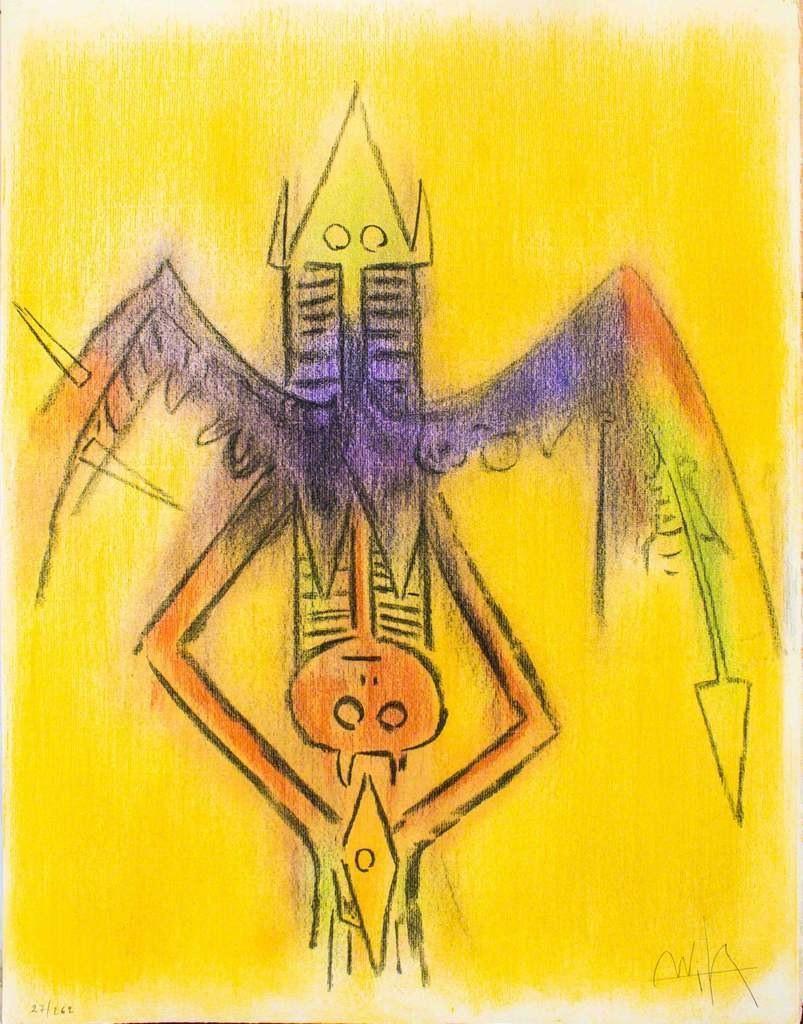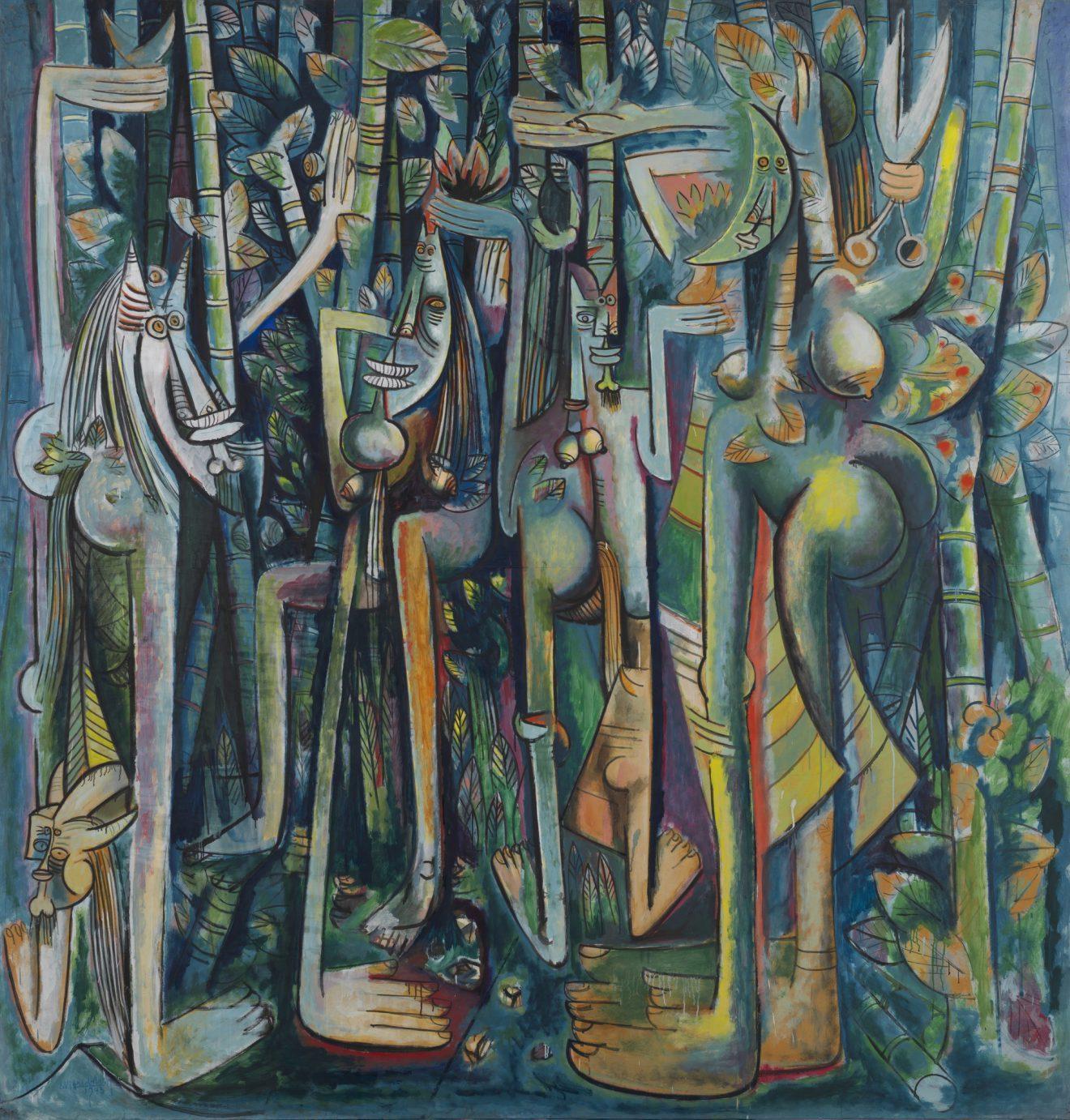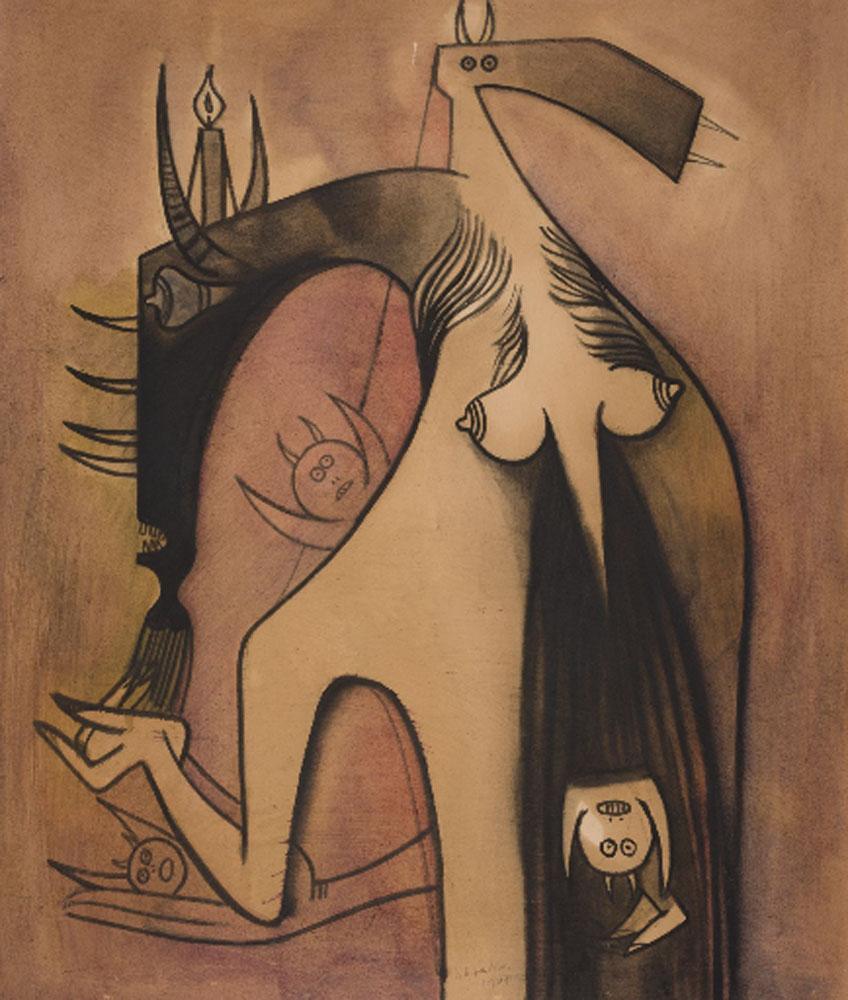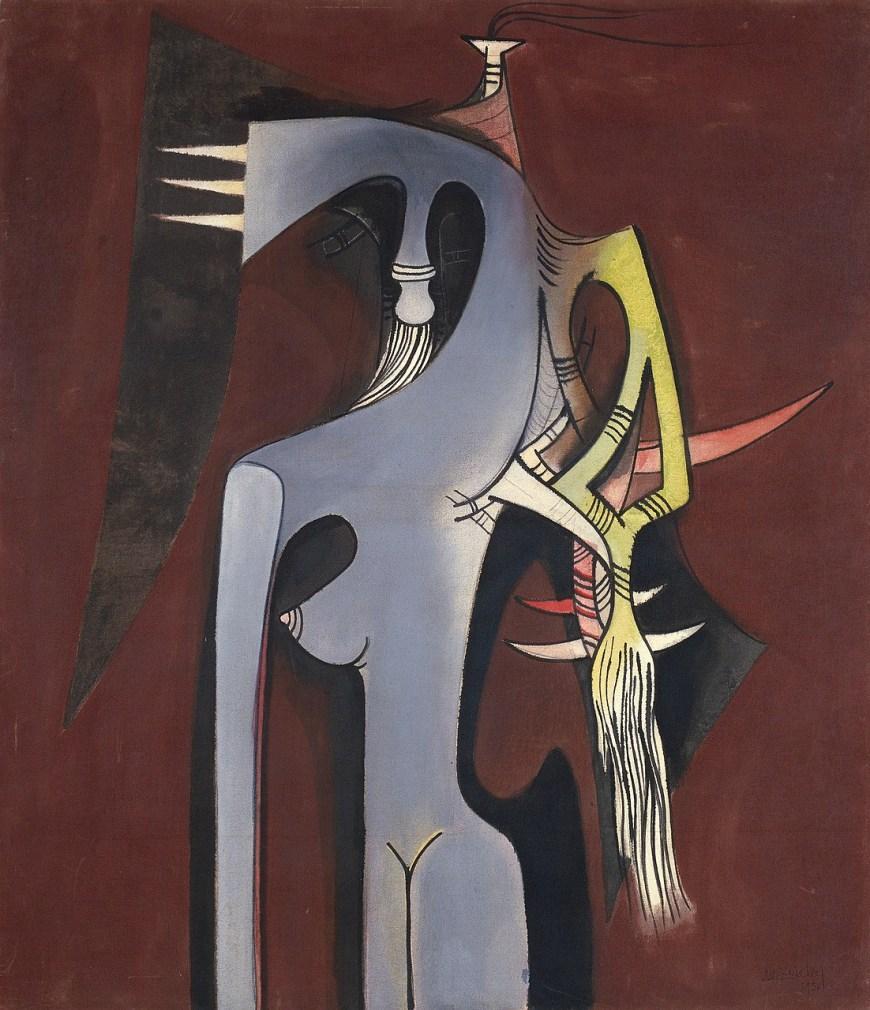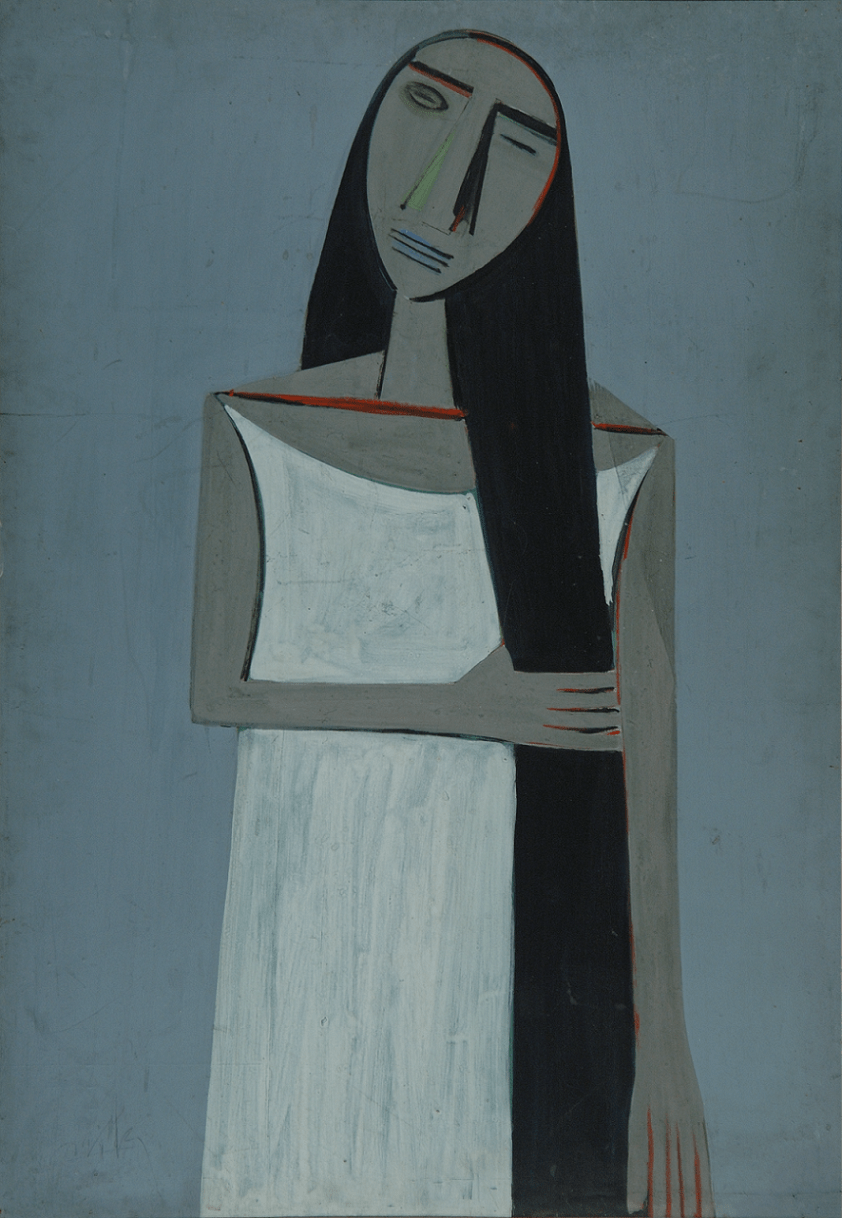After a brief period at the Academia Nacional de Bellas Artes San Alejandro in Havana from 1918 to 1923, Lam went to Spain and remained there from 1924 to 1938, first in Madrid and later Barcelona. By 1938 Spain had been devastated by civil war and Lam was forced to move to Paris. Picasso became very fond of Lam and introduced him to André Breton, Max Ernst and Victor Brauner, among others. From 1938 to 1941, Lam participated in the activities of the surrealist group, particularly from 1940 when he found himself in Marseilles with the surrealists who had been driven out of Paris by the war and the invasion of France.In 1940 Lam illustrated Breton’s Fata Morgana. He also became friends with Dominguez, Éluard, Masson, Tanguy and Michel Leiris. In 1941 he returned to the Caribbean accompanied by Breton, André Masson and Claude Lévi-Strauss, living in Haiti in 1947 and, from 1947 to 1951, in Cuba. After the end of the World War II, Lam travelled and worked all over the world including New York, Venezuela, Mexico City, Sweden, Italy, Chicago, often Paris and, following the Cuban Revolution, returning to Cuba where he put his international reputation at the service of the country’s cultural revolution and painted a fresco entitled Third World for the presidential palace in Havana.As a young painter, while continuing his academic training at the Prado Museum in Madrid, Lam discovered the fantastical and imaginary worlds depicted in the paintings of Dürer, Bosch and Brueghel. These, through an unexpected twist, provided him with an insight into the expressive possibilities of form and colour in the tropical vegetation and everyday life of his home country of Cuba. He also studied El Greco closely, admiring the rhythmic distortion in the slender elongation of his figures, a technique Lam would later adopt in his own work. He also discovered the fantastical, demoniacal and accusatory world of Goya, from which he would also draw inspiration. As well as the artworks of the past on display in Spain’s museums, Lam also discovered the Spanish architecture of the Middle Ages. And it was again through a kind of reverse journey of discovery that in Spain in 1928, he encountered African art through carvings from Guinea and the Congo. Lam was now in possession of all the cultural elements he needed to create his own artistic language.However, at this point the young artist’s life was torn apart when his wife and son died suddenly of consumption. The shock of this event and the agonizing sense of loss were probably instrumental in determining the underlying message of Lam’s later work: that the presence of death is at the very heart of life; that life is both fragile and precious; that all crimes against life are to be condemned. His paintings, which until then had shown an ordered reality, now became populated with magical presences, apparitions returning from the land of the dead. His personal tragedy was soon echoed on a wider scale by the Spanish Civil War: the dead proliferated around him with scenes of dead children and mothers holding dead children in their arms, and his painting expressed this universal drama.Lam painted his first great series, including the celebrated piece The Jungle dated 1942-1943, now in the Museum of Modern Art, New York, in Havana. This period of Lam’s life was one of key importance in the development of his art. José Pierre describes it thus: ‘ He was ready to express all the violent fervour of the primitive civilisations of the West Indies and Africa through means of exceptional lyrical vitality’. Lam’s visit to Haiti in 1947 revived his interest in the rich mythology of voodoo and produced a new and important explosion of inspiration. His accumulating work soon made his special world familiar – a jungle world of proliferating vertical stems with sharp, oblique leaves and thorns, populated by composite creatures with triangular heads, the general form becoming increasingly a shorthand of geometric signs adorning feathers, plumes and manes and other sharper features such as stings, claws and fangs. Many of these paintings are executed predominantly in harmonious browns or monochrome earth tones but others are splendidly coloured, displaying the full, rich spectrum of colours. It is not easy to analyse Lam’s work, indeed it is questionable whether one should even try or if he did so himself. His world has to be experienced, just as he experienced it himself when transcribing it. Like all true worlds, it is full of opposites, of beauty and horror, eroticism and death, of fact and of magic. Any attempt to decipher this ‘forest of symbols’ is likely to fail; we should simply listen to the ‘confused words’ emerging from it.Lam took part in collective exhibitions including: First Papers of Surrealism, New York (1942); International Surrealism Exhibition, Paris (1947); Prague (1948); Milan (1959); Paris, Buenos Aires, Lima, Santa Fe, Brussels, Amsterdam, Warsaw and Cracow (1960); 50 Years of Modern Art ( 50 ans d’Art moderne), Brussels (1958); Carnegie Foundation in Pittsburgh and Institute of Modern Art, Chicago (1959); Cuba – Painters of Today ( Cuba peintres d’aujourd’hui), Musée d’Art Moderne, Paris (1978); Art of the Fantastic, Indianapolis Museum of Art. (1987-1988).
There were relatively few solo exhibitions of Lam’s work prior to his return to the West Indies: Saga la Grande (1923); León, Spain (1932); Pierre (Loeb) gallery, Paris (1939). Later his work proliferated all over the world and he held a number of solo exhibitions including: Pierre Matisse Gallery, New York (1941, 1944, 1945, 1945, 1948 and 1950); Centre d’Art, Port-au-Prince (1946); Havana (1946); The London Gallery, London (1946); ICA, London (1952); Pierre Maeght gallery, Paris (1953); fine arts museum, Caracas and University of Havana (1955); Cahiers d’Art gallery, Paris (1957); Milan (1960); Totems and Taboos ( Totems et tabous), retrospective, Musée d’Art Moderne, Paris (1968); exhibition of lithographs at the Havana museum (1977); retrospective, Musée d’Art Moderne, Paris (1982). Posthumous exhibitions include: Maison de l’Amérique Latine, Paris and en exhibition of ceramics, Lelong gallery, Paris (1990); Lelong gallery in Paris (1991); Lam Métis, Musée Dapper, Paris (2001).



